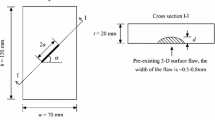Abstract
Triaxial compression experiments under confining pressures of 16 and 35 MPa were first carried out for hollow-cylinder sandstone specimens using a rock mechanics testing system. Four hollow-cylinder sandstone specimens were compressed to various deformation positions before or after the peak strength. Then, the compressed hollow-cylinder sandstone specimens were analysed using a three-dimensional X-ray micro computed tomography (CT) scanning system. Based on the horizontal and vertical cross-sectional CT images, the internal damage behaviour of hollow-cylinder sandstone specimens was evaluated. It can be seen that the crack system of hollow-cylinder sandstone specimens with higher compressed deformation after the peak strength are more complicated than those with lower compressed deformation close to the peak strength. In the present study, the hollow-cylinder sandstone specimens with lower compressed deformation are only dominated by some internal wall fractures resulting mainly from shear cracks, whereas the hollow-cylinder sandstone specimens with higher compressed deformation are mainly dominated by two shear fractures, as well as some tensile cracks. For the same axial stress level, hollow-cylinder sandstone under a higher confining pressure has a more complicated crack system than that under a lower confining pressure. The experimental results demonstrated that the three-dimensional cracks in the hollow specimen under triaxial compression are first initiated from the internal wall due to shear slippage, and then propagate towards the top or bottom boundary of the specimen in shear fracture mode. To better explain the internal crack evolution mechanism of hollow-cylinder sandstone during the entire loading, a conceptual model of hollow-cylinder sandstone material under the action of confining pressure is proposed. At the same time, the effect of the borehole size on the internal damage behaviour of the compressed specimen after the peak strength is also discussed. The investigated conclusions are significant for predicting the instability occurring around deep well bores in petroleum engineering and for ensuring the safety of deep excavation damage zones in tunnel engineering.



(Modified from Yang 2016)


















Similar content being viewed by others
References
Alsayed MI (2002) Utilising the Hoek triaxial cell for multiaxial testing of hollow rock cylinders. Int J Rock Mech Min Sci 39:355–366
Fairhurst CE, Hudson JA (1999) Draft ISRM suggested method for the complete stress–strain curve for the intact rock in uniaxial compression. Int J Rock Mech Min Sci 36(3):279–289
Feng XT, Chen SL, Zhou H (2004) Real-time computerized tomography (CT) experiments on sandstone damage evolution during triaxial compression with chemical corrosion. Int J Rock Mech Min Sci 41(2):181–192
Ge XR, Ren JX, Pu YB, Ma W, Zhu YL (2001) Real-in time CT test of the rock meso-damage propagation law. Sci China (Ser E) 44(3):328–336
Hawkes I, Mellor M (1970) Uniaxial testing in rock mechanics laboratories. Eng Geol 4:177–285
Hirono T, Takahashi M, Nakashima S (2003) In situ visualization of fluid flow image within deformed rock by X-ray CT. Eng Geol 70:37–46
Kawakata H, Cho A, Kiyama T, Yanagidani T, Kusunose K, Shimada M (1999) Three-dimensional observations of faulting process in Westerly granite under uniaxial and triaxial conditions by X-ray CT scan. Tectonophysics 313:293–305
Lee DH, Juang CH, Chen JW, Lin HM, Shieh WH (1999) Stress paths and mechanical behavior of a sandstone in hollow cylinder tests. Int J Rock Mech Min Sci 36:857–870
Meier T, Rybacki E, Backers T, Dresen G (2015) Influence of bedding angle on borehole stability: a laboratory investigation of transverse isotropic oil shale. Rock Mech Rock Eng 48(4):1535–1546
Mogi K (1966) Some precise measurements of fracture strength of rocks under uniform compressive stress. Rock Mech Eng Geol 4:41–55
Sufian A, Russell AR (2013) Microstructural pore changes and energy dissipation in Gosford sandstone during pre-failure loading using X-ray CT. Int J Rock Mech Min Sci 57:119–131
Wong TF, David C, Zhu W (1997) The transition from brittle faulting to cataclastic flow in porous sandstones: mechanical deformation. J Geophys Res 102(B2):3009–3025
Yang SQ (2016) Experimental study on deformation, peak strength and crack damage behavior of hollow sandstone under conventional triaxial compression. Eng Geol 213:11–24
Yang SQ, Jiang YZ, Xu WY, Chen XQ (2008) Experimental investigation on strength and failure behavior of pre-cracked marble under conventional triaxial compression. Int J Solids Struct 45:4796–4819
Yang SQ, Ranjith PG, Gui YL (2015) Experimental study of mechanical behavior and X-ray micro CT observations of sandstone under conventional triaxial compression. Geotech Test J 38(2):179–197
Yang SQ, Ju Y, Gao F, Gui YL (2016) Strength, deformability and X-ray micro-CT observations of deeply buried marble under different confining pressures. Rock Mech Rock Eng 49(11):4227–4244
Yang SQ, Ranjith PG, Jing HW, Tian WL, Ju Y (2017) An experimental investigation on thermal damage and failure mechanics behavior of granite after exposure to different high temperature treatments. Geothermics 65:180–197
Zhao GF, Russell AR, Zhao XB, Khalili N (2014) Strain rate dependency of uniaxial tensile strength in Gosford sandstone by the Distinct Lattice Spring Model with X-ray micro CT. Int J Solids Struct 51:1587–1600
Zhou XP, Zhang YX, Ha QL (2008) Real-time computerized tomography (CT) experiments on limestone damage evolution during unloading. Theor Appl Fract Mec 50:49–56
Acknowledgements
This research was supported by the Fundamental Research Funds for the Central Universities (2015XKZD05). I also would like to express my sincere gratitude to the editor Giovanni Barla, the associate editor Li Jian-Chun and two anonymous reviewers for their valuable comments, which have greatly improved this paper.
Author information
Authors and Affiliations
Corresponding author
Rights and permissions
About this article
Cite this article
Yang, SQ. Fracturing Mechanism of Compressed Hollow-Cylinder Sandstone Evaluated by X-ray Micro-CT Scanning. Rock Mech Rock Eng 51, 2033–2053 (2018). https://doi.org/10.1007/s00603-018-1466-5
Received:
Accepted:
Published:
Issue Date:
DOI: https://doi.org/10.1007/s00603-018-1466-5




